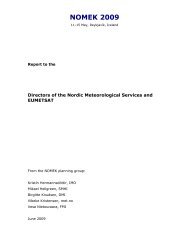International Symposium on Mitigative Measures against Snow ...
International Symposium on Mitigative Measures against Snow ...
International Symposium on Mitigative Measures against Snow ...
Create successful ePaper yourself
Turn your PDF publications into a flip-book with our unique Google optimized e-Paper software.
<str<strong>on</strong>g>Internati<strong>on</strong>al</str<strong>on</strong>g> <str<strong>on</strong>g>Symposium</str<strong>on</strong>g> <strong>on</strong> <strong>Mitigative</strong> <strong>Measures</strong> <strong>against</strong> <strong>Snow</strong> Avalanches<br />
Egilsstaðir, Iceland, March 11–14, 2008<br />
In fact a serious predicti<strong>on</strong>? is not possible. Alpine agriculture is no l<strong>on</strong>ger needed for<br />
supplying the populati<strong>on</strong> with food. Bavarian farmers al<strong>on</strong>e produce a milk volume which is<br />
three times greater than the Austrian demand (Keuschnigg, 2005). Alpine valleys are probably<br />
<strong>on</strong>e of the most intensively used tourism areas in Europe at present and also in the future and<br />
Agriculture has more and more the role of landscape c<strong>on</strong>servati<strong>on</strong>. Somebody has to pay for it.<br />
3.2 Climate change<br />
3,0<br />
2,0<br />
1,0<br />
0,0<br />
-1,0<br />
-2,0<br />
-3,0<br />
-4,0<br />
-5,0<br />
-6,0<br />
-7,0<br />
1906<br />
1909<br />
1912<br />
1915<br />
1918<br />
1921<br />
1924<br />
1927<br />
1930<br />
1933<br />
1936<br />
Temperatur Innsbruck Univ., Winter<br />
1939<br />
1942<br />
1945<br />
1948<br />
1951<br />
Figure 5 Winter temperature (m<strong>on</strong>thly mean values Dec – Feb) in Innsbruck 1906 –<br />
2004 (Gabl, 2005)<br />
Global warming is evident and is also expressed in the winter temperature over the last<br />
century. An expected, an increase of heavy precipitati<strong>on</strong> events is described in the third IPCC<br />
report (2007) for Europe. An exact regi<strong>on</strong>al forecast is not possible due to the lack and the<br />
shortness of data rows (Gabl, 2005). Climate models are not able to predict changes <strong>on</strong> a<br />
regi<strong>on</strong>al scale. Martin and others (2001) tried to find out how avalanche hazard will change<br />
under changed climate c<strong>on</strong>diti<strong>on</strong>s in the French Alps. They found – although their study<br />
should be c<strong>on</strong>sidered preliminary because of the very simple scenarios – that avalanche<br />
hazard will decrease slightly in winter, but the decrease is more pr<strong>on</strong>ounced in February. The<br />
frequency of major avalanche events can hardly be assessed. Formayer and others (2004)<br />
describe that about 50% of total precipitati<strong>on</strong> is expected to occur in form of heavy<br />
precipitati<strong>on</strong> in 2100. At the moment this value is approx. 35%.<br />
3.3 Protective measures<br />
To implement new protecti<strong>on</strong> work and maintain the old <strong>on</strong>e in a sufficient way is not<br />
possible with the same m<strong>on</strong>etary and pers<strong>on</strong>al input. At the moment the amount of m<strong>on</strong>ey that<br />
is needed for maintenance for avalanche protecti<strong>on</strong> c<strong>on</strong>structi<strong>on</strong>s is approx. 5 –7% of the<br />
Sauermoser 113<br />
1954<br />
1957<br />
1960<br />
1963<br />
1966<br />
1969<br />
1972<br />
1975<br />
1978<br />
1981<br />
1984<br />
1987<br />
1990<br />
1993<br />
1996<br />
1999<br />
2002<br />
2005











